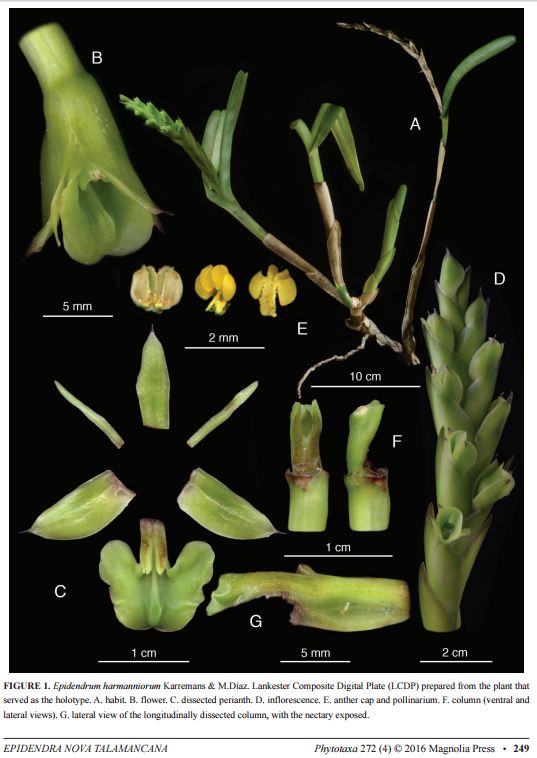

Epidendrum hartmanniorum Karremans & M.Díaz 2016 GROUP Spathiger SUBGROUP Coriifolium
LCDP Photo by © Karremans and The Reasearchgate Website

 LATE
LATE
Common Name The Hartman's Epidendrum [Landowners in the area where the species was found current]
Flower Size 1.2" [3 cm]
Found in Costa Rica on isolated trees in a montane rainforest, just above 2100 meters in elevation as a small sized, cold growing, scandent epiphyte with erect, cane-like, laterally compressed stems carrying 1 to 2, in the apical half of the stem, articulate, oblong to narrowly elliptic, deeply bilobed apically, subcoriaceous, margin entire leaves that blooms in the late spring on a a terminal, suberect, arising on a mature stem, distichous, racemose, occuring only once, laterally compressed, peduncle enveloped by 7 to 9, imbricating, conduplicate, carinate, acuminate, compressed bracts, successively 3 to 6, 5 to 9 flowered inflorescence with longer than the ovary, acute, conduplicate, divergent, slightly incurved, mainly green with purple at the apex floral bracts and carrying non-resupinate, the lip always facing the rachis, mainly green flowers with the base of the tepals and lip are purple.
"Epidendrum hartmanniorum is part of GROUP Spathiger SUBGROUP Coriifolium characterized by the sympodial habit, coriaceous leaves, and the racemose, distichous inflorescence carrying fleshy green to purplish flowers. The species is related to Epidendrum magnibracteatum Ames 1922 but differs by the smaller overall size, shorter stems, flowers almost half the size and successive flowers. Epidendrum hartmanniorum is also similar to Epidendrum palmidium Hágsater but is distinguished from it by the longer and wider leaves, smaller, successive flower and is apparently distributed at lower elevations. Epidendrum mocinoi Hágsater has similar flowers in size and shape, but can be distinguished by the lax inflorescence, the floral bracts shorter than the ovary and rounded rather than acute, the sepals completely spreading and the petals with the apex rounded to obtuse rather than acute." Karremans & M.Díaz 2016
Synonyms
References W3 Tropicos, Kew Monocot list , IPNI ; * Phytotaxa 272(4): 248–250, f. 1A–G. Karremans & Diaz 2016 drawing/photo fide
--------------------------------------------------------------------------------------------------------------------------
--------------------------------------------------------------------------------